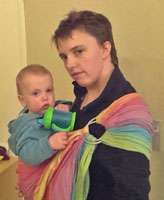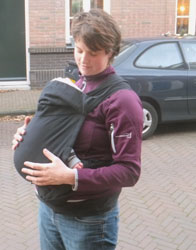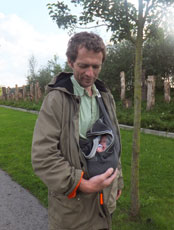Babywearing… but how?
So you decided… you want to wear your baby… but how? What will be practical? Wat do I find important about wearing my baby? How should it feel? Or maybe you did not decide yet…; what products are on the market to wear your baby in? What are the prices? Is it quick enough for my taste? Is it not too heavy? Or too complicated?
However, to know something about it would be nice. And then.. there seam to be just as many carry systems, variations and wraps, as there are people who carry… Which is the best for YOU, we can discuss when you contact me. Underneath, on this page I tried to make a short overview of the advantages and disadvantages, so you can compare. Then you know what we are talking about. And maybe you already get an idea of your preferance. This way, I like to enable you to avoid the mistakes I made because of ignorance!
There is extremely much to tell and to find about different wraps and every person is so different that it could well be that you do not find the answer to your question, or that you experience differently than other people. That is just why I kept the overview short! For elaborated explanations about specific wraps, carries or carriers, you can scroll around on blogs. My personal carrying blog you can find here.
To be short, the next babywearing systems are generally known:
- Stretchy wrap
- Woven wrap
- Ring Sling (short woven wrap worn over the shoulder)
- Mei tai (and podaegi)
- Baby Carrier (or Soft Structured Carrier, SSC)
 Stretchy wrap
Stretchy wrap
The stretchy wrap is often seen as ideal for newborns up untill about, let’s say, 6 months of age. Some find the stretchy wrap not comfortable anymore after 3 months, while others still like to wear their one-year-old! You can tie this wrap in advance, and thén get your baby in the wrap. This is a great advantage. The stretchy wrap is often seen as a wrap with which you can only tie one type of carry, but there are more possibilities. With most stretchy wrap, you can only carry in front or on the hip. Three layers of wrap are ‘mandatory’ to support your baby enough and to carry it safely. These 3 layers can be warm, especially with a newborn in the summer this is not always experienced as ideal. On the other hand, there are also very thin stretchy wraps.
 Woven wrap
Woven wrap
One advantage of a woven wrap is that you can do many carries and tying variations. From day one untill toddler you can carry your baby. The other important advantage is that it is very comfortable; if wrapped well, it is the most comfortable way to wear a baby. The weight is evenly distributed on both shoulders, the back and the hips. With a woven wrap you can carry in front, on your hip or on your back.
There are many sizes (size 1 to 8). Just so you know already; size 6 is the most used size. For confection sizes untill size 44, you can do many carries with this size, including the most used carry for newborns and older, the Front Wrap Cross Carry (FWCC), a frontcarry. A size 6 measures 4.60 meters. This might seem very long to you, but you will need all that length, you will see…
A disadvantage of this type of wrap, is that you have to tighten it while you put your baby in the wrap. This can be a little frightening at first, and discouraging. With the right instructions you will be able to wear your baby safely and comfortably.
There are very many different brands, different thickness and different blends of different textile fibre types, each with their own properties. There are woven wraps of 50 euros and of 500 euros. Do not let yourself be turned crazy in the wrapping world; a wrap of 50 euros will do just fine.
With a short woven wrap, for example a size 2 (about 2.60 meters) you can do a hip carry. With a slipknot this works a bit like a ring sling. There are more sizes, each with their own set of carries which it is suitable for. But other sizes are usually something to look for when you have an older child and you would want to do short type carries.
 Ring Sling
Ring Sling
A ring sling is a short woven wrap with 2 rings sewn to one end. The other end is threaded through the rings. This way a system of pulling tight and releasing again, appears. Usually a ring sling is only for hip carries. It is relatively quick to put your child in the ring sling, so it is also often used for older babies and toddlers who like to be carried only now and then and for the short walks from your bike to the grocery store and from your car to the daycare. Carrying in front is also possible and you could even do a back carry with the ring sling. You can use the ring sling from day one until the end of toddlerhood.
The big disadvantege of this type of wrap is that you carry your baby on one shoulder; it is uneven and the same spot is always used to carry the child. For people with back problems, the ring sling usually is not an option for that reason. There are several ways how the rings are sown to the wrap; spread out or sewn with pleats etcetera. Again; all with their own advantages and disadvantages. A safe ring sling has rings from one piece, WITHOUT any seem visible. Rings with a seem can break, but fortunately they are hardly available nowadays.
 Mei Tai
Mei Tai
The Mei Tai (ponounced as in English) is a carrier based on asian carriers and it consists of one rectangular piece of fabric with four ties; one at every corner. The rectangular holds your baby and with the four ties you tie it to your body. Depending on the with of the ties and possible padding in the ties, the weight is more or less distributed over your body. The mei tai is a system which is also often ‘home made’. A mei tai has to fit your baby. This depends on the sizes of the rectangular. It means that you can use it less long than for instance, a wrap or ring sling. On the other hand, there are also adjustable mei tais available.
 Baby Carrier
Baby Carrier
A baby carrier or often short called SSC (Soft Structured Carrier) is a system with buckles. There are many different carriers available. Just like there are ergonomic ways and non-ergonomic ways to carry your child, there are also ergonomic carriers and non-ergonomic carriers on the market. Unfortunately there are a few well-known, popular brands which produce non-ergonomic carriers (while claiming that they are ergonomic). With an ergonomic carrier, you cannot do much wrong.
In general, a baby carrier is relatively easy and quick to put on. You hardly have to mind tension, as you would with a woven wrap or ring sling. How long a baby carrier will fit, is also restricted, just as it is for the mei tai.
There are also adjustable baby carriers available and there are bigger sizes, for toddlers for instance. There are only a few brands which are suitable for newborns. Which brand and type of baby carrier is most comfortable, is different per person. There are many beautiful prints available
Where to buy?
Nowadays there are many webshops which are specialized in wraps and carriers. Stone shops where you can get personal advice and see and feel and try on wraps and carriers are scarce. Usually you do not intendently go to a shop to try wraps or carriers to order it elsewhere. In and around Amsterdam there are a few physical ‘stone’ shops;
- Draagkracht in Utrecht
- Kinderwinkel Teuntje. Baby Carriers, wraps and ring slings. One of the employees is babywearing consulent. Haarlemmerdijk (Amsterdam Centre)
Webshops which are specialized in wraps and carriers: Naturebabies.nl Dragenenzo.nl slingomama.com
Brands
Brands of ergonomic carriers: Marsupi, Bondolino, Ergobaby, Manduca, Beco, Boba, Tula, Rose&Rebellion, Wompat
Brands of wraps ‘budget’: Hoppediz, Little Frog, Yaro, Amazonas
Other brands of wraps: Girasol, Babylonia, Bykay, Didymos, Ellevill
High end wraps:: Oscha, Kokadi, Danu, Artipoppe, CariSlings
About Ergonomics
There is much to be said about ergonomics. The principle of ergonomic babywearing, is that you support your baby’s body optimally to enable her/him to relax totally while avoiding possible danger so your child can develop itself physically and mentally well and discover&explore the world from a safe base.
Practically, ergonomic babywearing implies that, while being carried, your child has a posture which is quite similar to the foetus-posture the child had when it was in its mother’s womb. A newborn baby will, if you enable it to do so, lift the knees and make its back round, with the arms folded before its face.
Eventually, ergonomics mean that the person carrying the child is also safe and comfortable.
Underneath a few simple rules are stated in order to check whether a child is carried in an ergonomic way;
- The head should be supported. This implies support up till the neck, at the height of the underside of the ear. Support which would go up higher, does not give enough ventilation possibilities, and support that stays lower, is just not enough. The neck and back muscles are not developed yet, especially for the first 4 months.
- The back should be, especially for young babies, round-like
- The knees should be lifted higher than the bum
- The bum and legs should be supported from knee to knee. Not further; the lower legs hang relaxed downward.
- The person carrying the child should be able (whilst front carrying) to kiss the forehead without any effort
- Your child should be in sight & clearly visible
- Enough ventilation is important; nose and mouth should be free of any clothing and not be covered with any fabric
Examples of NON-ergonomic ways are:
- Carrying sideways (also known as cradle carry). The chin can sag easily onto the chest. Breathing can then be obstructed.
- A carrier in which only the bum is supported, while the legs hang from the hips downward. This is not good for the hips, which are in an early stage of development.
- A carrier with a hard support piece, which ‘forces’ the baby’s body into a straight position.
- Facing forward. It is almost impossible in this position to support the legs from knee to knee. The child cannot shut out the outside world and rest and does not have any eye contact with the parent, which is its reference. All of these things can be extremely (mentally) tiring.
- In a wrap or Ring Sling, facing forward is still not ergonomic.
- With too much space for the head, so the head can swing around and is not supported.
- With a headsupport which supports the head by the chin/ the face instead of the neck or the back of the head (this usually occurs when babywearing facing forward)
- With the lower legs inside the wrap or carrier. Too much pressure will occur to the feet; the entire body weight presses down on the feet. This pressure goes all the way through the knees towards the hips, which is nog good for the development of these joints.
Non-ergonomic carriers and carries:


